
Protected Cruiser Varyag (1899)
The ship with six lives*
The Russian cruiser Varyag was a ship that was commissioned in 1901 and played an important role in the Russo-Japanese War. The Varyag was part of the Russian Pacific Fleet, and was stationed in the port of Port Arthur in Manchuria when war broke out.
On February 8, 1904, a Japanese fleet attempted to blockade the port, and the Varyag was ordered to break through the blockade and attempt to make it to the safety of the Russian port of Vladivostok. Despite being heavily outnumbered and outgunned, the Varyag fought bravely, inflicting significant damage on the Japanese fleet before finally being forced to scuttle itself to prevent capture.
The story of the Varyag became a symbol of Russian bravery and resilience in the face of overwhelming odds, and the ship itself became a legendary figure in Russian naval history. The wreck of the Varyag was eventually salvaged and its bell is now on display at the Central Naval Museum in Saint Petersburg.
*(US Built, Imperial Russian(i), Imperial Japanese, Imperial Russian(ii), “Red” Russian, British).
Design of the class
Origins and development
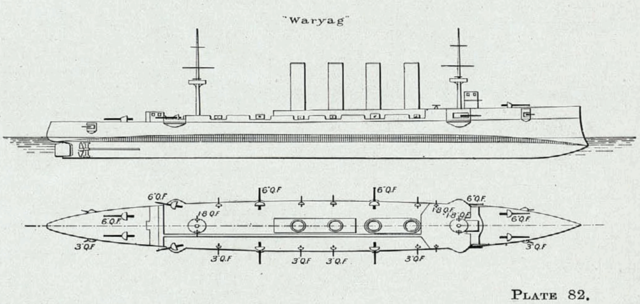
On Brassey’s naval annual 1900
In 1895 after the 1st Sino-Japanese war won by the latter, western powers made a triple intervention to force the rather harsh treaty of Shiminoseki and in 1898, Russia signed a 25-year lease on the Liaodong Peninsula, proceeding to set up a naval station at Port Arthur. This enabled the possibility of a pacific fleet, for which there was no ship available yet. A large naval expansion program was decided, which comprised cruisers and soon battleships. All cruisers were designed with the same capabilities in mind.
According to the Russian Admiralty, one of the new cruisers needed was designed to be a fast and well protected, capable of long-range operations, armed with a variety of weapons to be self-sufficient: Artillery of all calibers, torpedoes and mines as well. This was formulated in 1897 by the Russian Admiralty, and this called for a fast protected cruiser capable of commerce raiding.
There were associated requirements, having 152 mm (6-inch) quick-firing guns, and a 23–24 kn (43–44 km/h; 26–28 mph) top speed. But at the time, Russian yards were already at full capacity and unable to deliver, therefore the idea soon emerged of a foreign purchase, but there was no time for international request for proposals. The commission just looked after the ideal yard.
On 11 April 1898 and order for a single cruiser based on this specification was submitted to Cramp and accepted. Other cruisers at the same time were asked to Germaniawerft for Askold, AG Vulcan for Bogatyr based on the very same specifications. This would lead the admiralty to do also comparative tests.
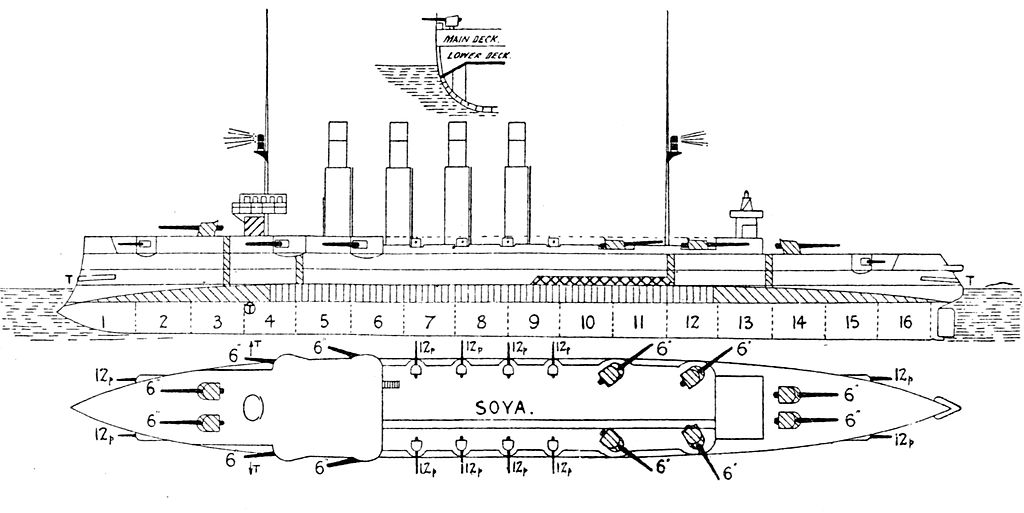
Jane’s fighting ghips rendition in 1899, left elevation
The US yard Cramp Shipbuilding, William Cramp & Sons Shipbuilding Company or William Cramp & Sons Ship & Engine Building Company of Philadelphia (founded 1830) and renown as the most preeminent U.S. iron shipbuilder of the late 19th century was not chosen at random. It proposed a tailored design, which also had some consequences on USN own cruiser designs. Apart Trans-Atlantic liners, the company also signed the USS Baltimore (C-3) in 1888 USS New York in 1891, USS Indiana (BB-1), or USS Iowa (BB-4) in 1896. Varyag was completely different that usual US cruisers designs, and could not be compared to the “masted commerce raiders” built up to that point. They also digested lessons from the 1898 war, something that also drawn the attention of the Russian commission.
Eventually Varyag was laid down in October 1898 and launched on 31 October 1899, one of the fastest cruiser built in the world at the time, but commissioned into the Imperial Russian Navy on 2 January 1901. Her first captain was Vladimir Behr.
As for the usual crunchy anecdote, during construction, an assistant physician, Leo Alexandroff, deserted the advanced sailors party on 20 April 1899 and applied for U.S. citizenship. He was arrested for desertion, but his case reached the US Supreme Court, which ruled that the ship was still not accepted for service when in happened and under the terms of the 1832 treaty between Russia and the United States, still nominally in US possession via its shipyard, so under the yard’s staff authority. In short, she was still “possessed” by the US, hence her six lives (US, Russian, Japanese, Russian imperial/bolshevik and British). Nevertheless, Alexandroff was returned to Russian authorities.
Hull and general design
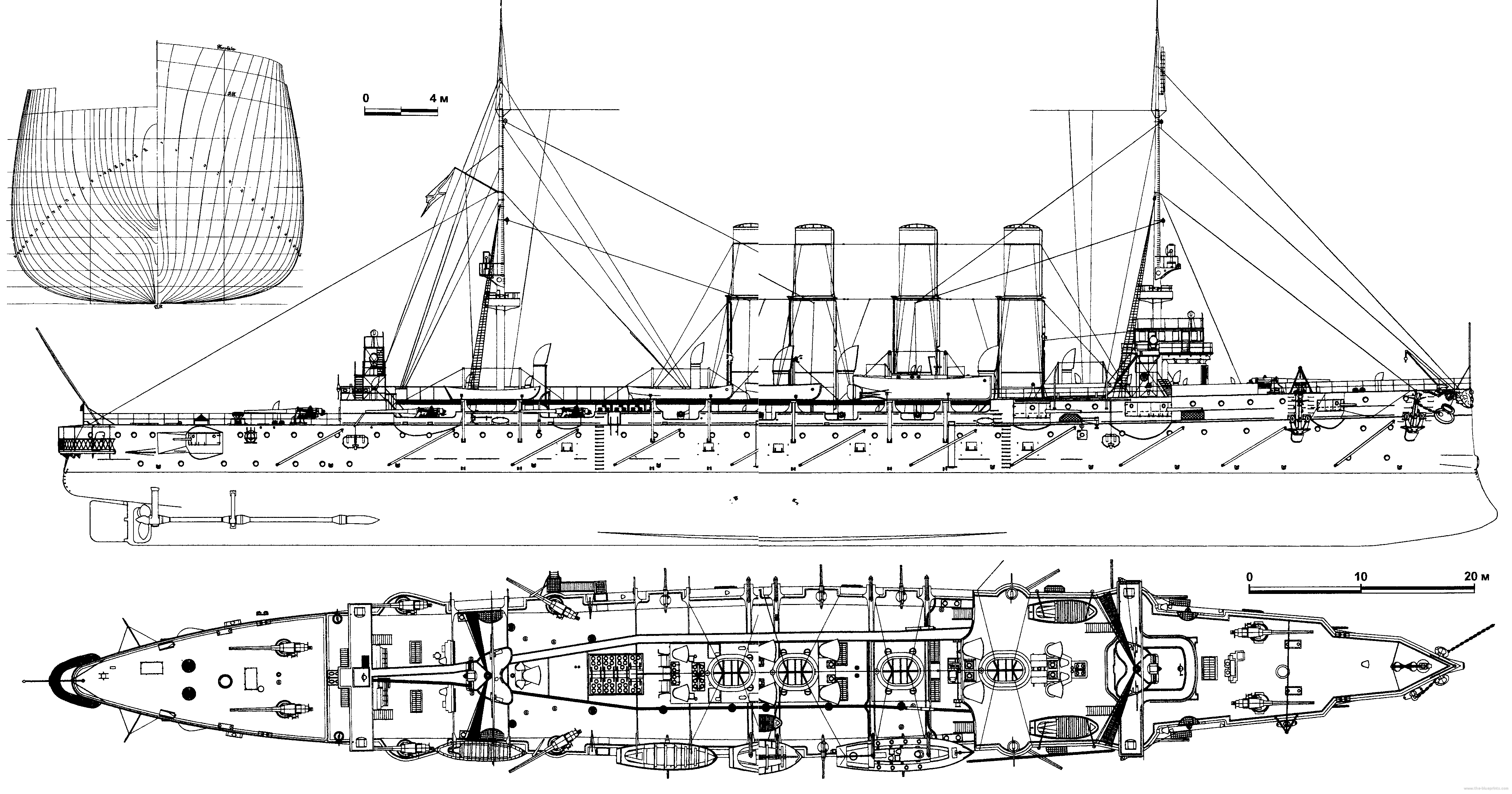
Varyag was a 6040 tons standard, 6,500 tons fully loaded ship, 129.56 m long by 15.9 m (in beam without plating) and with a mean draft of 5.94 m* midships. According to US practice she had a tall freeboard, with a nearly four deck high forecastle and two deck high aft hull. She had a good ratio for speed, 1/9, and good seakeeping. Her silhouette as typical of both US and Russian cruisers of the time, with a forward bridge tower built above the conning tower (which was rather large and three stages high), top open bridge with chadburn and voice pipes, and wings with communication lights, followed by fore military mast carrying a fighting top and above a platform for the forward projector. The hull ended forward with a reasonably bulging ram bow and reinforced prow.
Like the mainmast aft, in front of the small lattice aft platform carrying projectors and guns, it was a single tubular and upwards decreasing steel piece. Amidship were located five tall and heavenly spaced funnels, composed of two-parts. They were tall enough to not smoke over the spotting tops. This central part was dotted with cowl vents and locations of boats. The three main coal barges, steam cutters and whalers were planed on davits, three per side. The four outer ones were pinnaces and yawls, two close to the bridge and two aft abreast the mainmast.
The Crew comprised 20 officers, 550 sailors and non-commissioned officers. It was planned to use the steam pinnaces to carry landing parties off-shore and dismountable small arms could be added as support (see below).
Armour protection layout
As a protected cruiser, Varyag had the “usual panoply” combining a turtledeck above the steering, machinery spaces and ammunitions rooms, combined with a belt along the waterline. The conning tower was the only upper protected part. No guns had shields. This Armor deck comprised several thicknesses depending of the angle and locations, ranging from 38 mm (horizontal section) to 57 mm and 76 mm (3 inches) on the slopes. The armor belt was in fact internal and sloped as part of the final section of the armor deck. The large conning tower was the best protected part of the ship with walls 152 mm (6 in) thick, weighting 588 tons alone. It comprised an upper bridge command deck pierced with loopholes for peripheral vision, and a map deck below.
There was also 38 mm (1+1⁄2 in) of armour protecting the ammunition hoists, and 76 mm (3 in) protecting the bow and stern torpedo tubes.
Powerplant
Two shafts, with three-bladed bronze propellers connected via shafts to two Cramp steam Engines of the vertical triple expansion type, fed in turn by 30 Niclausse steam boilers (Russified as “Nikloss”) for a total output of 16,198 shp, for a top speed of 23.2 knots, 20.5 knots however in 1905, and 16 knots cruise speed, and a cruising range at 10-knot of 6,100 miles (with full supply of coal) down to 3,270 miles with the normal coal supply load.
Armament
Main
The ship was delivered unarmed. Her main armament comprised twelve Obukhoff 152 mm (6-inch) L/45 guns: Two guns side by side on the forecastle, two side-by-side on the quarterdeck. The remaining eight were on sponsons on the upper deck. None was protected, unliked what it is shown on Jane’s. They fired a 50 kg (110 lb) shell at 9,800 m (10,700 yd) with a rate of fire of 6 rounds per minute. In all, the ship carried total 2,388 rounds main ammunition, both HE and AP. More
Secondary
Varyag also had twelve 75 mm (2.95 in) L/50 QF guns for anti-torpedo boat warfare. They were located alongside the battery deck amidship and in hull casemates.
They could could fire a 6 kg (13 lb) HE shell to 7,000 m (23,000 ft) at 10 rounds per minute.
This was completed by eight Hotchkiss 47 mm revolving cannon, with two on each fighting top, four more on the upper deck.
This was completed by two 37 mm (Hotchkiss ?) revolving guns and two Maxim machine guns but also two dismountable Baranowski 64 mm landing guns (on wheeled carriages, fitted on pintles forward of the steam pinnaces) also carried for landing parties.
Torpedoes and Mines
Varyag was fitted with six 381 mm (15 inch) torpedo tubes, two on each broadside, one in the bow and stern each. They were likely the standard Howell 15-in type of the day, or possibly Whitehead-Fiume type. As for mines, it was at first planned, but no railings was ever installed as shown on plans.

⚙ specifications |
|
| Displacement | 6,500 long tons (6,604 t) |
| Dimensions | 129.6 x 15.8 x 6.3 m (425 ft 2 in x 51 ft 10 in x 20 ft 8 in) |
| Propulsion | 2 shafts VTE, 30 Niclausse boilers 20,000 ihp (15,000 kW) |
| Speed | 23 knots (43 km/h; 26 mph) |
| Range | 6,100 miles |
| Armament | 12× 152mm, 12× 75mm, 8× 47mm, 2× 37 mm, 6× 381 mm TTs |
| Protection | See notes |
| Crew | 570 |
Read More
Books
Buxton, Ian (2001). “Question 36/99: Imperial Russian Cruiser Variag”. Warship International. XXXVIII
Campbell, N. J. M. (1979). “Russia”. Conway’s All the World’s Fighting Ships 1860–1905.
Kowner, Rotem (2006). “Historical Dictionary of the Russo-Japanese War”. Scarecrow.
Smigielski, Adam (1979). “Imperial Russian Cruiser Varyag”. In Roberts, John (ed.). Warship Volume III. Conway
Wetherhorn, Aryeh (2001). “Question 36/99: Imperial Russian Cruiser Variag”. Warship International.
Links
Full Plans from shipmodell.de
On ru.wikipedia.org
en.wikipedia.org
Japanese_cruiser_Soya wiki
On tsushima.su
http://sic-transit.ru/
commons.wikimedia.org/wiki/Category:Varyag_
zn.ua/
https://sergeyurich.livejournal.com/
On youtube
Model Kits

Zvezda 1:350 old kit on scalemates.com/ The full lists includes a Limited Edition (Full Model kit w/Deck & Detail-up Parts) by ArtwoxModel 1:350 AA10001 2012, Zvezda 1:350 9014 2010 kit, and 2003 New toolling kit, Combrig 1:700 70133 Mks R-005 and by Modelkrak 1:700.
Early Career of Varyag (1901-1905)
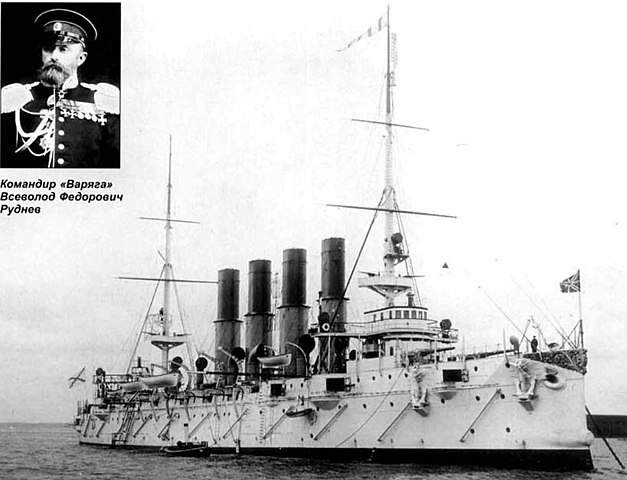
Captain Rudnev and Varyag as completed
Varyag (her name referred to the Byzantine “Varangian Guard”) after commision in the US, Philadelphia, on 2 January 1901, spent the first years in training, 1901, 1902 and 1903 in the Baltic before departing for the far east. From the beginning of January 1904, with arrived at the neutral Korean port of Chemulpo, at the disposal of the Russian embassy in Seoul, in presence of other ships from England, France, USA and Italy.
On February 8, 1904, the Japanese squadron (Asama and Chiyoda, Naniwa, Niitaka, Takachiho, Akashi and 8 destroyers) blocked Chemulpo to cover the landing and prevent Varyag to intervene. The same day, there was a sortie from to Port Arthur but upon leaving the port, the relief fleet was attacked by IJN destroyers which two fired self-propelled mines and missed, after which they fold back. The Japanese landing of 2,000 troops was not interfered with.
On February 9 Varyag’s captain Vsevolod Fedorovich Rudnev received an ultimatum from the squadron’s admiral: Leave the port of Chemulpo before 12 o’clock, or be attacked in the roadstead. Rudnev decided to break through and fight his way to Port Arthur, and scuttle his ship if failing to do so. At noon, Variag and the gunboat Korietz left Chemulpo and saw the Japanese squadron behind the island of Phamildo.
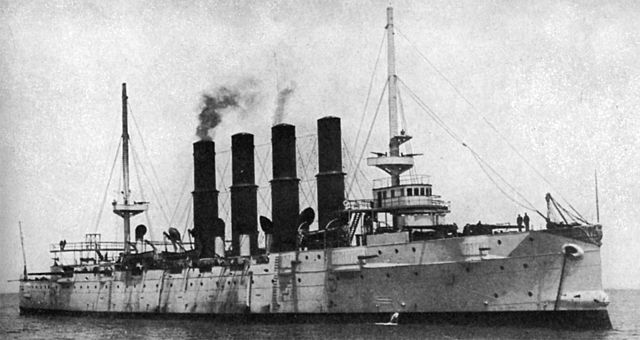
The Battle of Chemulpo Bay: Varyag felt the weight of Admiral Uriu’s squadron of six cruisers and tried a heroic gamble, counting on his speed and firepower. His break out attempt from Chemulpo (Incheon) started on 9 February 1904. As promised, he put up quite a fight. For an hour, Varyag manoeuvered well to try and dodge enemy volleys while firing 1,105 shells at the enemy, and the gunboat Korietz 52, although it could have been well overestimated. The Gunboat later blanketed both with a smoke screen for added protection. So that they could leap frog in and out of this cover while firing. According to Rudnev, his cruiser sank one destroyer and damaged IJN Asama, the armoured flagship, as well as the older Chiyoda. Official Japanese sources never confirmed this.
Anyway, his ship suffered numerous hit, and he lost 31 men, with 191 injured; He eventually decided to return to the harbor for repairs, counting at 1:00 p.m. the neutrality to apply.
His damage as reported were the broken rangefinder station number 1, 6-inch guns No. 3, IX, XII, 75-mm gun No. 21, 47-mm guns No. 27 and No. 28 were knocked out, rangefinder station No. 2 destroyed, guns No. 31 and No. 32 were blow away, all 47-mm guns damaged by shrapnels, five 6-inch guns damaged, seven 75-mm guns damaged, steering gears pipe broken, four underwater holes, upper funnel shattered, all fans broken, commander’s quarters destroyed. Rangefinder officer Count Nirod and 38 lower ranks were killed, 3 officers wounded like midshipman Gubonin, Laboda and Balk as well as 70 lower ranks. Captain Rudnev himself was shell-shocked and received a head wound. After the battle, 24 wounded Russian sailors were treated in Chemulpo, but two died. Another 11 were treated aboard foreign ships present.

A disabled Soya in Chemulpo
The crew decided not to surrender but to sink their ship. They were evacuated onto the British cruiser Talbot, French cruiser Pascal, Italian cruiser Elba but this was protested by US gunboat Vicksburg’s captain, which dedided against taking these crews onboard due to U.S. neutrality. A preliminary agreement was reached before the scuttling of the Varyag, assorted with an obligation not to take part in subsequent hostilities and return to Russia through neutral ports.
On March 19, 1904, the first group of 300 arrived in Odessa on the steamer Malaya, and the third and last group arrived on April 6. In total, 30 officers and 600 sailors as well as from the gunboat, and 55 sailors from the Sevastopol plus 30 Cossacks of the Trans-Baikal Cossack Division in Seoul arrived by ship to Odessa. From there they proceeded to Sevastopol, and to St. Petersburg, through Simferopol.
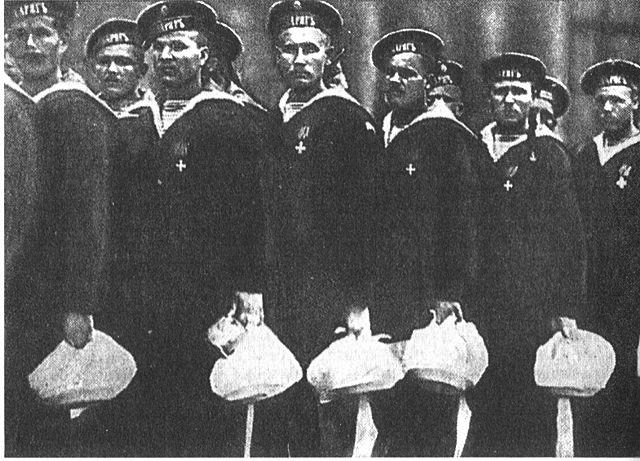
Crew ceremony in 1904
On April 16, 1904, sailors and officers arrived in St. Petersburg as heroes and lining up in columns, they marched from the Nikolayevsky railway station to the Winter Palace Square, greeted by Emperor Nicholas II, later invited to a gala dinner at the palace for the celebration of their “last stand”. All sailors were also gifted personalized watches by the Tsar. In 1907, Vsevolod Rudnev, promoted to rear admiral, was decorated with the Japanese Order of the Rising Sun for his heroism in that battle, at the Japanese Embassy. This was a unique honor made by the Japanese to a foreign officer. It was accepted, but never wore in public. There was a stele erected also by the Japanese in Seoul in memory of the Varyag.
As IJN Soya (1907-1916)
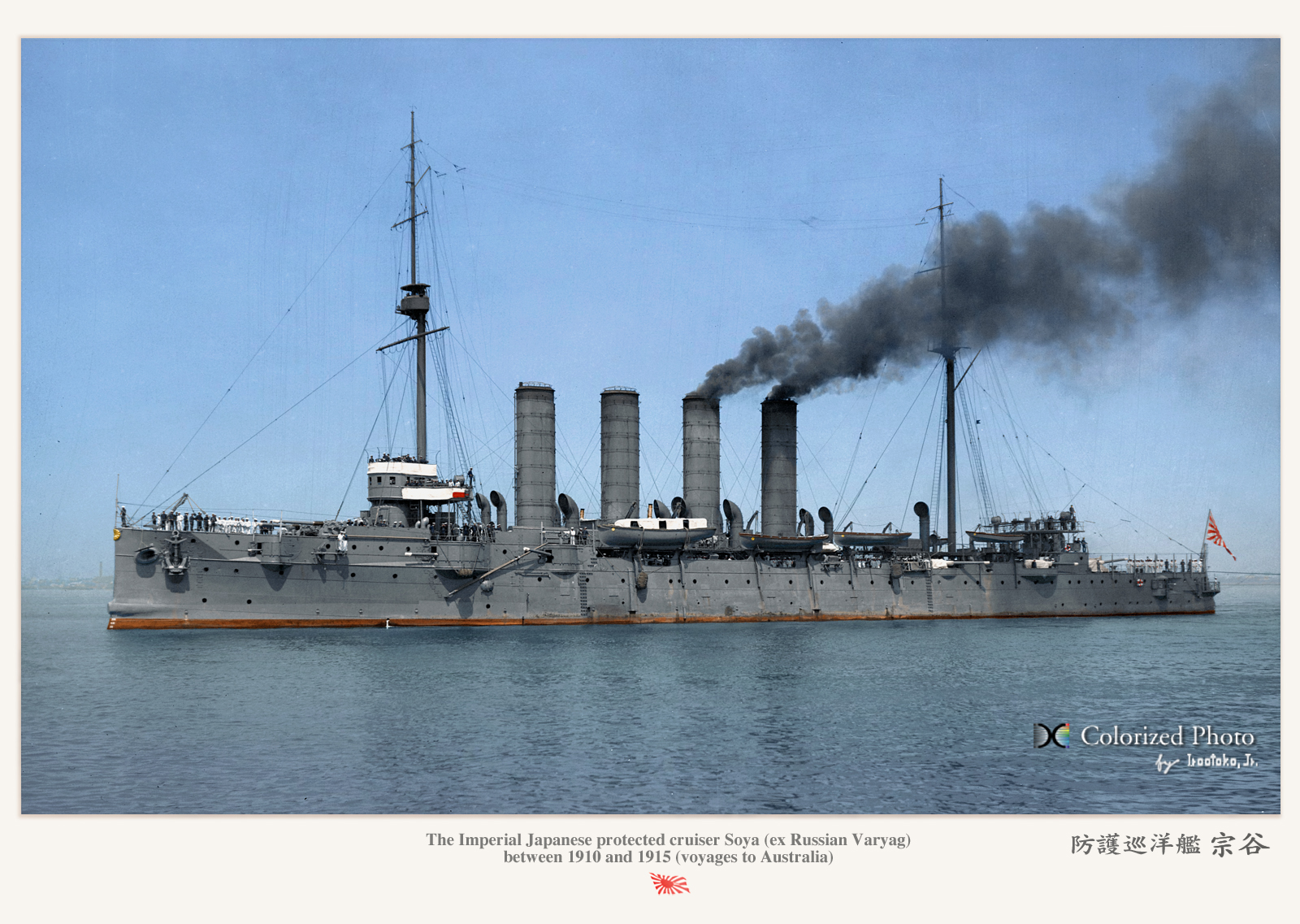
IJN Soya as colorized by Irootoko Jr. Photographed during one of her trips to Australia.
After the Russo-Japanese War, Varyag was raised on August 8, 1905 from Chemulpo harbor and repaired by Japan, arriving on the 22th. With modifications to IJN standard she was commissioned as the 2nd class cruiser “Soya” (Jap. 宗谷 after the Japanese name of the northernmost cape of Hokkaido, Cape Soya Misaki) on 9 July 1907. After trials and initial training, she was re-rated as a 3rd class cruiser and used for training. From 14 March 1909 to 7 August 1909, she made navigational and officer cadet cruises, notably to Hawaii and North America, even stopping at Cramp. These training cruises went on yearly until 1913.
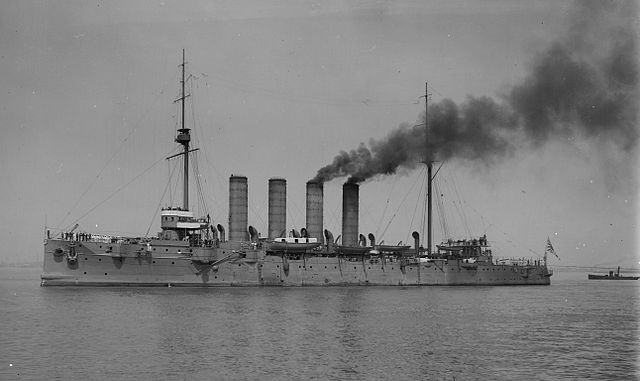
The same original photo
For more than seven years it was used by the Japanese for training, but as a tribute to her past career, the name “Varyag” was left on the stern by personal decision of Emperor Mutsuhito. From March 14 to August 7, 1909 Soya went to the Hawaiian Islands and North America for long distance navigation and train officers. On December 1, 1915 she made her last long cruise.
Indeed after 1914, Russia at war badly needed ships, and now both Empires being again united, had the Tsar’s government demanding Tokyo to send them back IJN Soya along with several other vessels, to be transferred at Vladivostok, on 5 April 1916. She was of course renamed Varyag upon delivery. During the First World War, the Russian Empire and Japan became allies. Soya together with the battleships Sagami and Tango were bought back by Russia. On April 4, the Japanese flag was lowered and on April 5, 1916, the cruiser was officially renamed as “Varyag”, reassigned in the Arctic flotilla, and prepared to start her long trip back home.
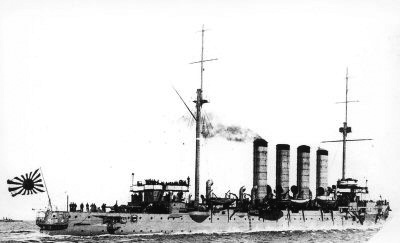
Stern view of IJN Soya
Late career of Varyag (1916-1918)
After changing colors, Varyag proceeded to the baltic, a reverse of the baltic fleet long voyage undertook to the far east in 1905. In June 1916, she departed for Murmansk, via the Indian Ocean through November 1916 and arrived in Liverpool for recoaling and an overhaul at Cammell Laird, in February 1917. She was set to resume service in the Arctic squadron when the Revolution broke out on 7 November 1917. Some informed Russian crewmen, despite their officers ademonestations, hoisted the red flag and refused to obey orders. The situation became quite tense for the British Government, which sent warships and troops to deal with the issue. Eventually on 8 December 1917 she was seized by force, with a detachment of British soldiers.
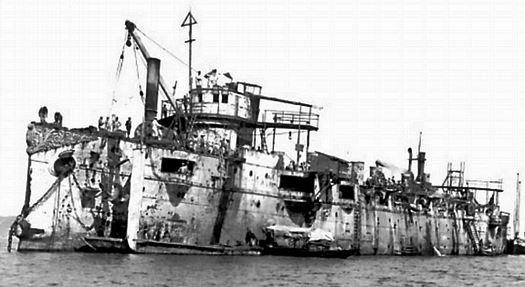
IJN Soya wrecked in the forth of forth
Later she was confiscated since the Soviet government refused to pay the Russian Empire debts. Provisionally assigned to the Royal Navy in February 1918 (she changed hands a 5th time, the “reds” was the 4th…). In 1920, she was resold to a German shipbreaker. But the proud vessel refused her fate and while under tow, she met a storm and ran aground off the western coast of Scotland, near Lendalfoot, Firth of Clyde, Irish Sea. Since 1923, she stayed there until, pillaged, and later local companies removed part of her metal structures. What left sank. Later she was blown up and the remaining scrap metal was salvaged. Nothing is left of her but her flag (and bell), now at St Petersburgh and presented for great occasions. The 1980s Slava-class heavy cruiser “Varyag” perpetuated the tradition.



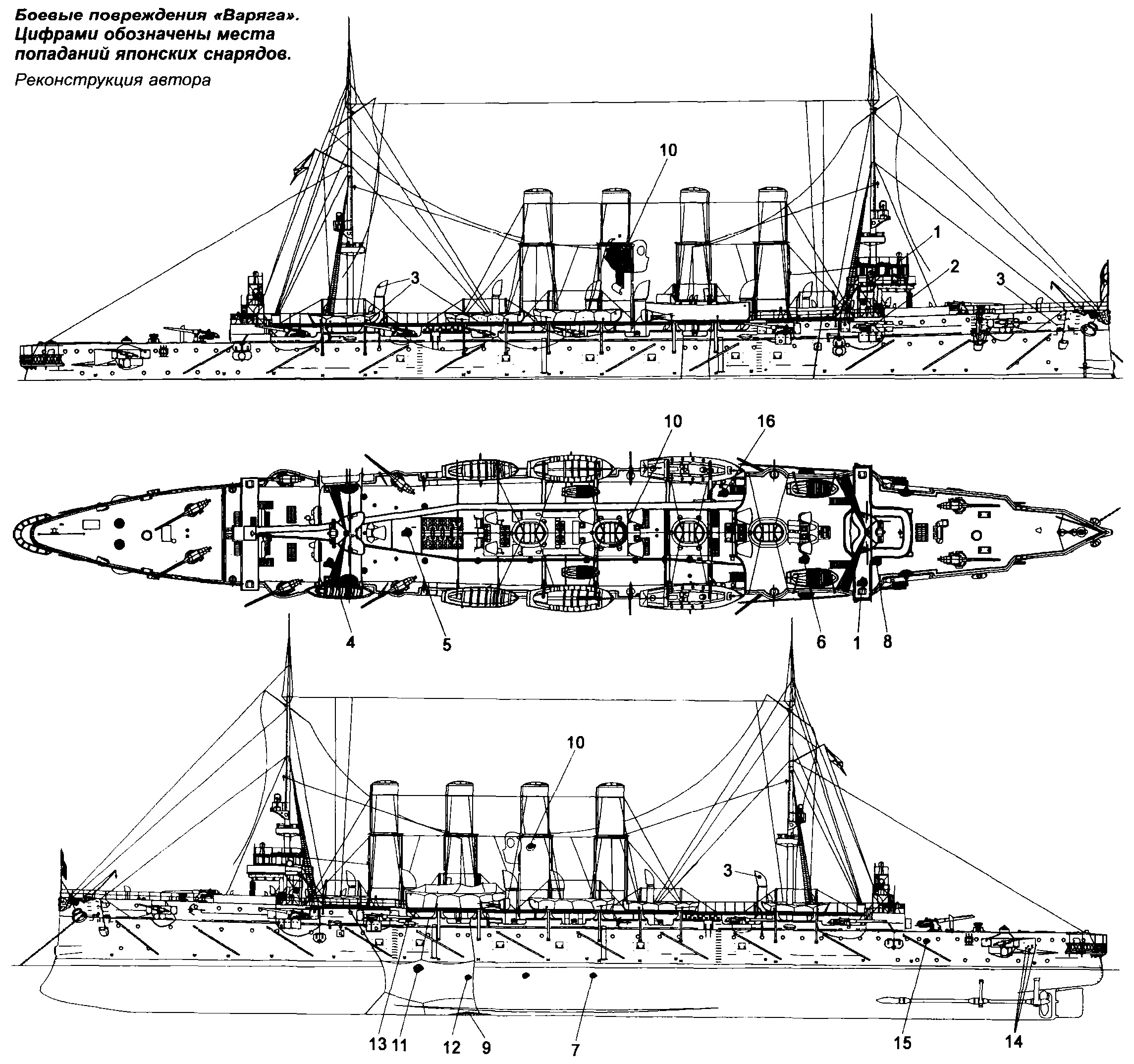
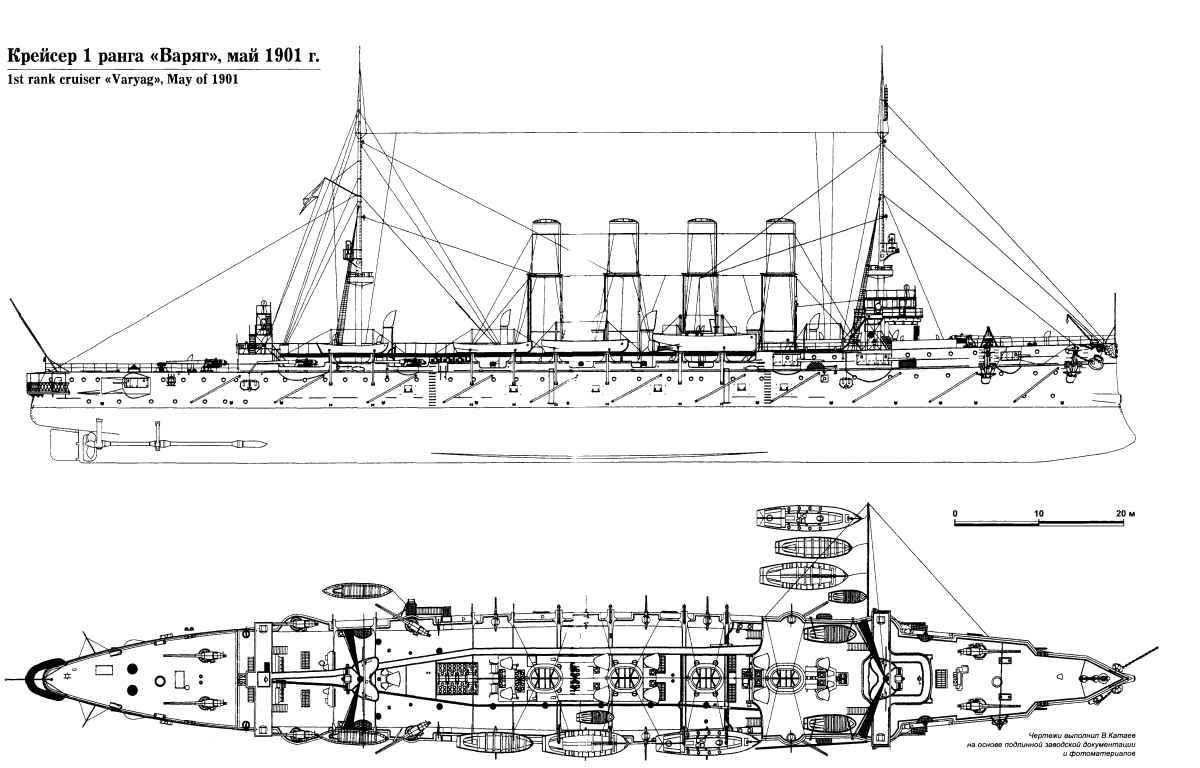
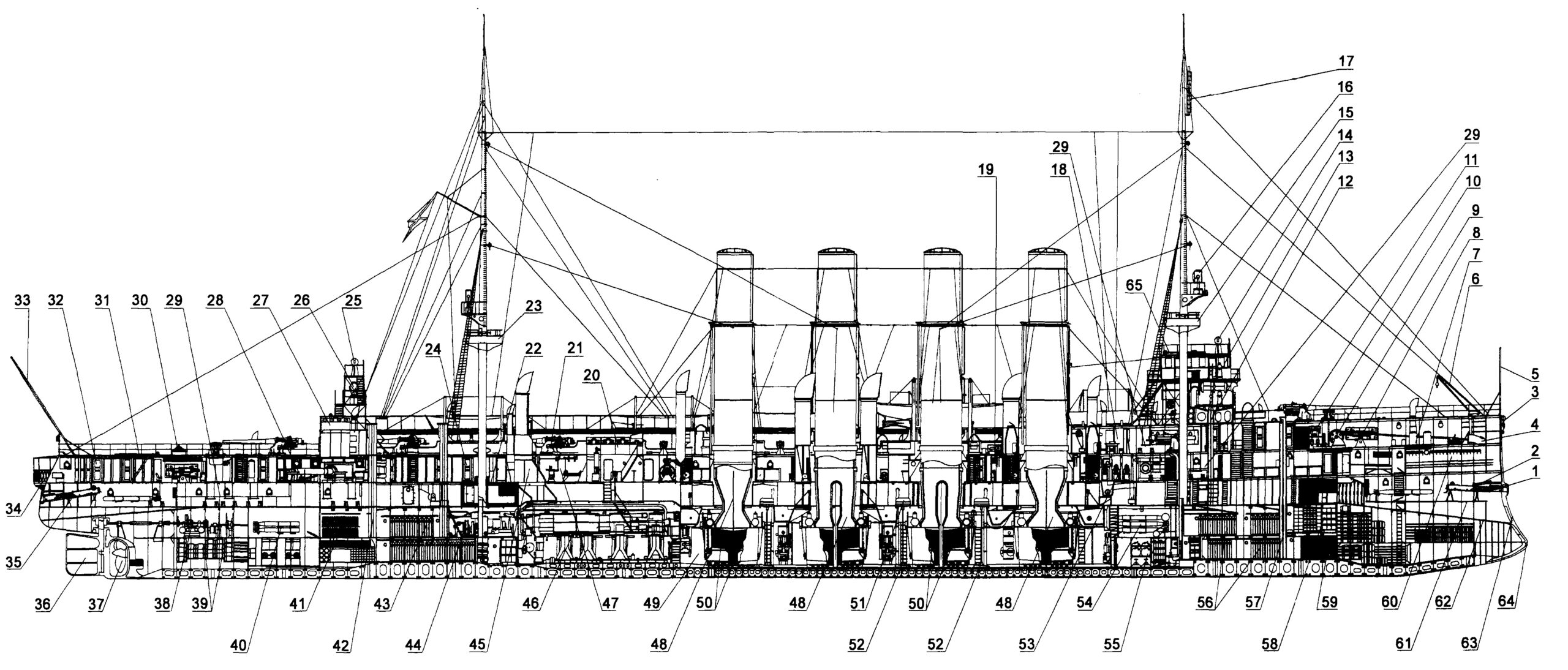
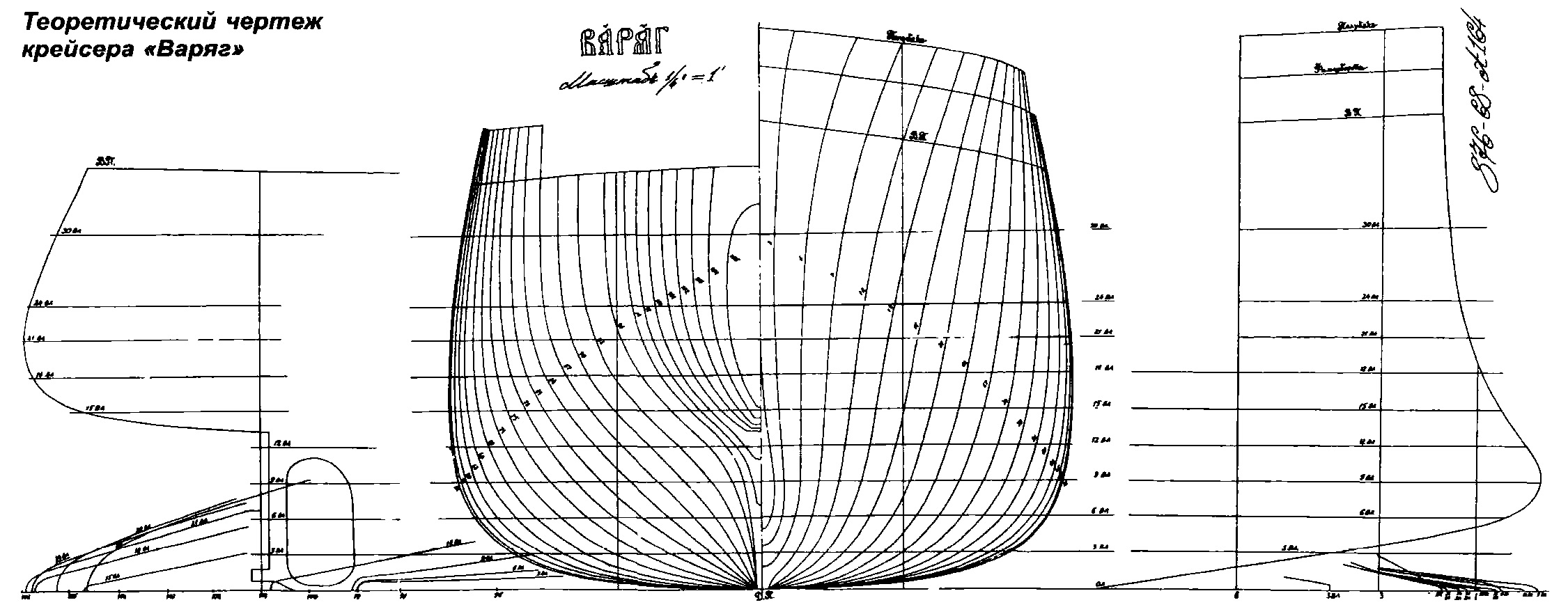
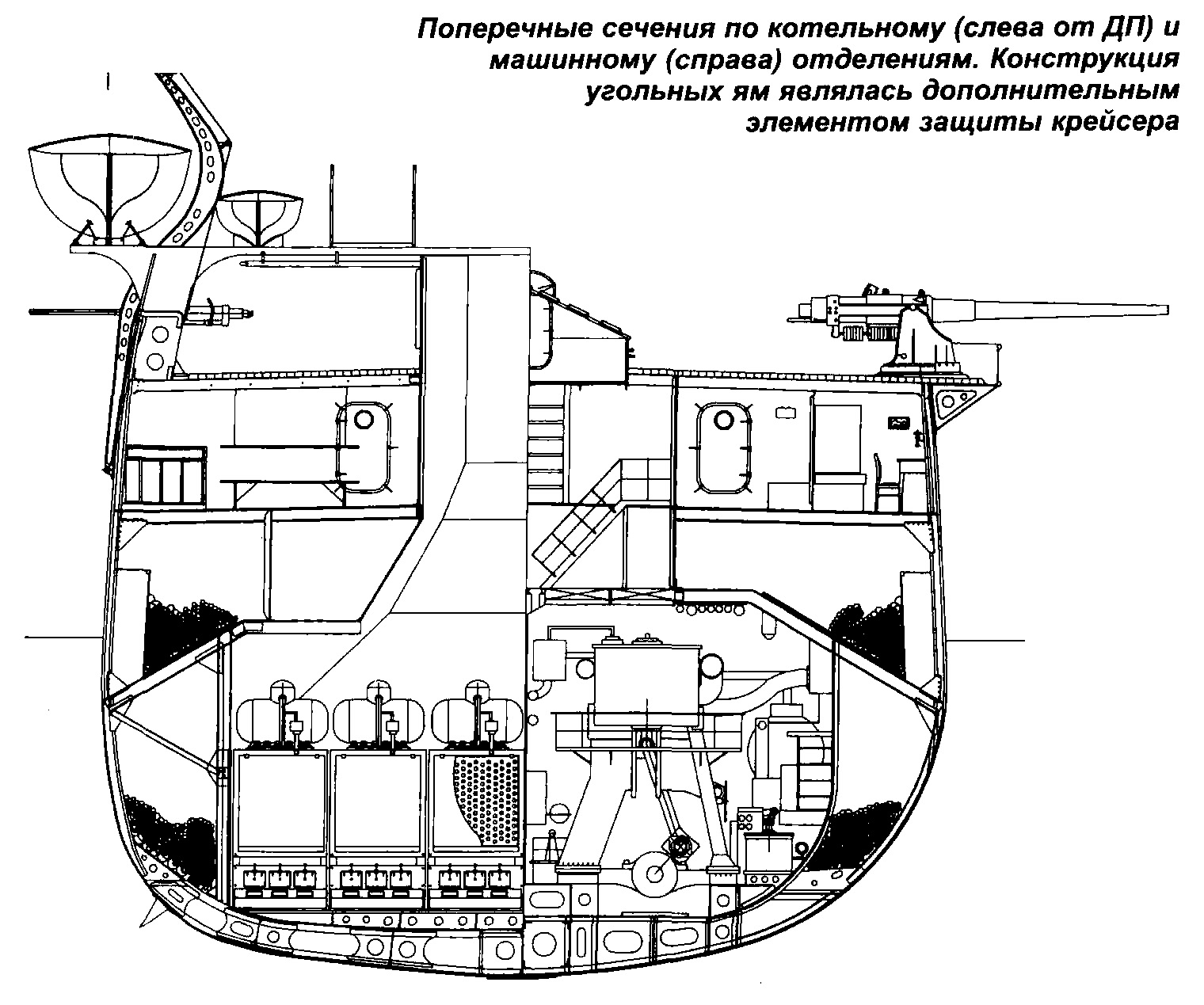
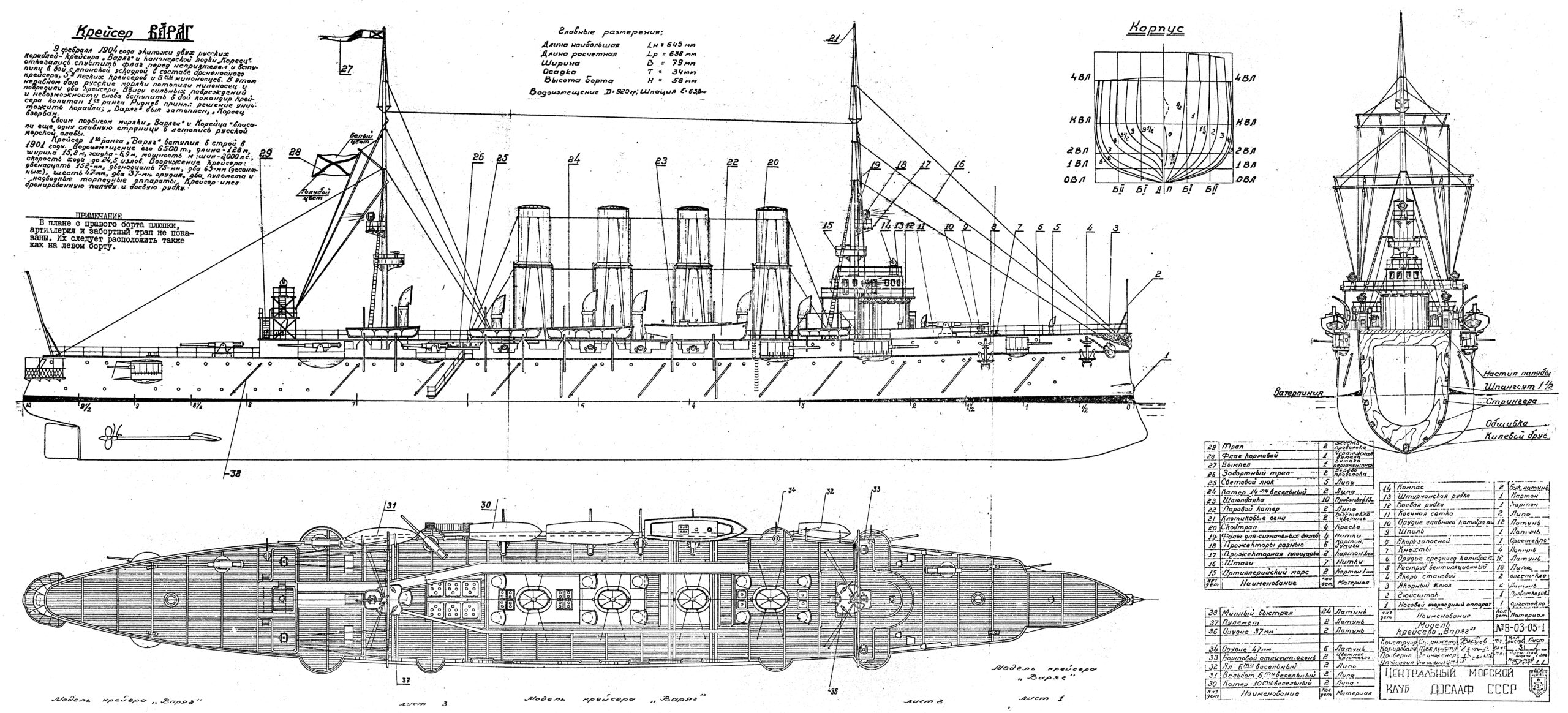
 Latest Facebook Entry -
Latest Facebook Entry -  X(Tweeter) Naval Encyclopedia's deck archive
X(Tweeter) Naval Encyclopedia's deck archive Instagram (@navalencyc)
Instagram (@navalencyc)





 French Navy
French Navy Royal Navy
Royal Navy Russian Navy
Russian Navy Armada Espanola
Armada Espanola Austrian Navy
Austrian Navy K.u.K. Kriegsmarine
K.u.K. Kriegsmarine Dansk Marine
Dansk Marine Nautiko Hellenon
Nautiko Hellenon Koninklije Marine 1870
Koninklije Marine 1870 Marinha do Brasil
Marinha do Brasil Osmanlı Donanması
Osmanlı Donanması Marina Do Peru
Marina Do Peru Marinha do Portugal
Marinha do Portugal Regia Marina 1870
Regia Marina 1870 Nihhon Kaigun 1870
Nihhon Kaigun 1870 Preußische Marine 1870
Preußische Marine 1870 Russkiy Flot 1870
Russkiy Flot 1870 Svenska marinen
Svenska marinen Søværnet
Søværnet Union Navy
Union Navy Confederate Navy
Confederate Navy Armada de Argentina
Armada de Argentina Imperial Chinese Navy
Imperial Chinese Navy Marinha do Portugal
Marinha do Portugal Mexico
Mexico Kaiserliche Marine
Kaiserliche Marine 1898 US Navy
1898 US Navy Sovietskiy Flot
Sovietskiy Flot Royal Canadian Navy
Royal Canadian Navy Royal Australian Navy
Royal Australian Navy RNZN Fleet
RNZN Fleet Chinese Navy 1937
Chinese Navy 1937 Kriegsmarine
Kriegsmarine Chilean Navy
Chilean Navy Danish Navy
Danish Navy Finnish Navy
Finnish Navy Hellenic Navy
Hellenic Navy Polish Navy
Polish Navy Romanian Navy
Romanian Navy Turkish Navy
Turkish Navy Royal Yugoslav Navy
Royal Yugoslav Navy Royal Thai Navy
Royal Thai Navy Minor Navies
Minor Navies Albania
Albania Austria
Austria Belgium
Belgium Columbia
Columbia Costa Rica
Costa Rica Cuba
Cuba Czechoslovakia
Czechoslovakia Dominican Republic
Dominican Republic Haiti
Haiti Hungary
Hungary Honduras
Honduras Estonia
Estonia Iceland
Iceland Eire
Eire Equador
Equador Iran
Iran Iraq
Iraq Latvia
Latvia Liberia
Liberia Lithuania
Lithuania Mandchukuo
Mandchukuo Morocco
Morocco Nicaragua
Nicaragua Persia
Persia San Salvador
San Salvador Sarawak
Sarawak Uruguay
Uruguay Venezuela
Venezuela Zanzibar
Zanzibar Warsaw Pact Navies
Warsaw Pact Navies Bulgaria
Bulgaria Hungary
Hungary

 Bundesmarine
Bundesmarine Dutch Navy
Dutch Navy Hellenic Navy
Hellenic Navy Marina Militare
Marina Militare Yugoslav Navy
Yugoslav Navy Chinese Navy
Chinese Navy Indian Navy
Indian Navy Indonesian Navy
Indonesian Navy JMSDF
JMSDF North Korean Navy
North Korean Navy Pakistani Navy
Pakistani Navy Philippines Navy
Philippines Navy ROKN
ROKN Rep. of Singapore Navy
Rep. of Singapore Navy Taiwanese Navy
Taiwanese Navy IDF Navy
IDF Navy Saudi Navy
Saudi Navy Royal New Zealand Navy
Royal New Zealand Navy Egyptian Navy
Egyptian Navy South African Navy
South African Navy






























 Ukrainian Navy
Ukrainian Navy dbodesign
dbodesign